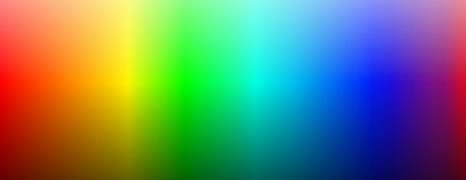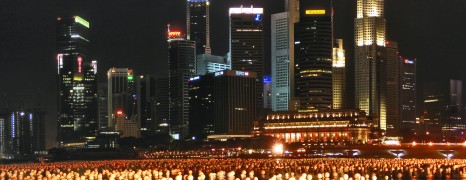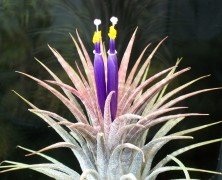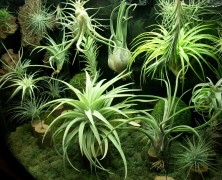LEDs are more energy efficient. LEDs last longer. These claims are becoming more and more prevalent, and rightfully so. But this breakthrough light source represents another tremendous advantage, one that is far less well known: the LED color spectrum. The “white” visible light emitted naturally by both the sun and artificial light sources is actually composed of a range of colors. These various colors can be viewed when the light is refracted through a dispersive prism. The different colors of light represent different wavelength frequencies — the typical human eye can perceive wavelengths from about 390 to 700 nm. While sunlight is composed of the richest compilation of color (within it you will see all the colors of the rainbow), many other forms of artificial “white” light are missing wide swaths of the color spectrum. Looking at the color distribution of incandescent (top) and CFLs (bottom) in the charts below, we see that there are large sections of the full spectrum missing from each of these forms of white light. In incandescents, the lower wavelengths of blue, green all the way to yellow are found at a greatly diminished value. In CFLs, on the other hand, the apparent white light is something like a visual trick, composing narrow bands of violet, blue, green and orange color frequencies to trick our brains into thinking we’re seeing white light. Below is the color spectrum found in LEDs. Notice how the LED color spectrum is heavier on the blues, and claims a more even distribution than CFLs or red heavy incandescents. The reason for this is that many LEDs are run using more efficient blue chips which shines through a phosphor coating that turn the light white. So what’s the difference between the LED color spectrum and the spectrum found in other artificial light sources? The main difference is that the LED spectrum is closer to natural daylight than incandescents, which more closely resemble sunset light, or CFLs, which are composed of narrow bands of light. The color spectrum of LED lights signal to our body’s internal circadian rhythm, a critical player in cognition and mood, that we are in a daylight situation. This makes us feel more alert, in addition to helping fight symptoms of depression. In contrast, incandescents, heavy on the red spectrum, can actually decrease alertness and increase fatigue. Interestingly, the LED color spectrum has also proven beneficial in poultry LED lighting. Chickens raised under LED lights were found to respond positively to the LED color spectrum, which enhanced growth rates while reducing food costs and increasing the amount of eggs per chicken. Furthermore, the LED color spectrum has led to great results for indoor gardeners and horticulturists. Up until now, we have only covered one way to make white LED light — a blue LED light shone through phosphor. Another method is known as RGB, which blends red, green and blue LEDs together into white. While a less developed technology than phosphor-based white LEDs, RGB-based LEDs have the advantage of increasing the dynamism of the LED color spectrum. By using remote-controlled color-changing RGBs, the LED color spectrum can be adjusted to change at different times of the day or for various situations at home or work. Any Questions? Inspired to learn more about LED lights? We’d love to lend a hand and discuss LED strip lighting possibilities whenever you’re ready. Contact: Phone: 1-844-FLEXFIRE (1-844-353-9347) Email: info@flexfireleds.com Website: flexfireleds.com ...
How LED Lights Are Helping Address Climate Change...
posted by Flexfire LEDs
In New York City, 300,000 to 400,000 people recently took to the streets calling for action on climate change. These concerned world citizens would be pleased to note that as we shift away from inefficient incandescent bulbs, those who choose LED lights are helping address climate change by minimizing humanity’s environmental impact. Electricity production is the single largest contributor to CO2 emissions, accounting for 38% of U.S. emissions from 1990-2012. LEDs help us address climate change by lowering our electricity demand and therefore lowering our CO2 emissions. While installing LED strip lights in your kitchen won’t stop global warming, if you choose to make the investment in LEDs, you’re doing your part to slow its progress. Here are the top environmental reasons for choosing LEDs over other conventional lighting sources: Energy Efficiency High quality LED lights work at 80% efficiency. That means that 80% of the electricity used by an LED chip goes straight into producing light. Compare that to an incandescent bulb, which in many cases is just 20% efficient — 80% of the electricity used is transferred into heat instead of light. The U.S. Energy Information Administration estimates that in 2012, lighting constituted 17% of the total energy used by homes and businesses in the United States. Switching our lights over to LEDs, making them use electricity with 80% more efficiency, would have a dramatic impact on our CO2 emissions. There are other cases where LEDs will come in handy as well, such as LED refrigerator display lighting and poultry farming, where we can further lower energy demands since cool LED running temperatures require less artificial cooling. Furthermore, LEDs produce directional light, meaning light isn’t wasted in directions where it isn’t needed. Less Waste The typical lifespan of an incandescent bulb is 750 to 1,000 hours. CFLs,...
The Future Of LED Lighting: A Brave New World
posted by Flexfire LEDs
What’s the biggest difference between LEDs and other forms of lighting systems? Is it that they’re 85% more efficient than incandescent bulbs? Or that they last thousands of hours longer than CFLs? While there are obvious benefits, according to Fast Company, the most revolutionary component of LEDs is likely to be their ability to recognize digital signals. For the first time, our lighting systems are going from analog to digital. No longer do lights just turn “off” or “on.” Now they can be “tuned” to emit any color of the rainbow, or change temperature and brightness, all from the touch of a finger on your smartphone app. We’re now staring at the future of LED lighting, and it’s a beautiful, brave new world. Since 2007, the U.S. has been effectively phasing out inefficient incandescent lighting through federal regulations enacted in the Energy Independence and Security Act. After starting out with an effective ban on 100-watt incandescent bulbs in 2012, followed by 75-watt bulbs in 2013 and 60- and 40-watt in 2014, LEDs have been the industry favorite as a replacement for Edison’s monumental invention over a century ago. One of the first reasons that LEDs took off instead of efficient but sterile CFLs is that they contain solid-state lighting (SSL) semiconductors. It was just twenty years ago Nichia’s Shuji Nakamura invented the blue LED in Japan. By covering the blue light in phosphorous coating, the industry was soon able to introduce a white LED light onto the market. While the first generation of LED lighting failed to outperform traditional lighting sources in performance and pricing, the predictable improvement curve of SSL has led prices to fall dramatically as product research and investment has skyrocketed. By 2013, Cree had released a LED bulb that looked and felt like a 60-watt incandescent, priced at under $14. By 2014, the LED lighting market is estimated at $17.4 billion and is predicted for rapid growth through 2020. The current rise can be explained mostly by LED technology’s superior durability, efficiency and performance in comparison to other lighting technologies. Further, the emergence of home automation and the “Internet of Things” will only serve to catapult LEDs to deeper and deeper market penetration rates. Here are benefits that digital networks and intelligent home automation systems hold for the future of LED lighting and human well-being. Health Benefits: “You have to start thinking of light as a drug,” said Terry K. McGowan, the director of engineering for the American Lighting Association, in an interview with nytimes.com. That means that we have to start recognizing the impact lighting has on our mental and emotional states. As artists have known for a long time, color affects our moods and can elicit emotional and physiological responses. For example, blue wavelengths in light — which LEDs are rich in due to their reliance on blue lights — have been shown to help us stay awake. Furthermore, LED lights can be programmed to follow the natural light rhythms of sunlight. This will increase human well-being by maximizing the efficiency of our circadian rhythms to indoor lighting, increasing focus, energy and fighting insomnia and depression disorders. Installed at work, automated LEDs will be able to increase worker productivity. Installed in the bedroom, automated LEDs will be able to help us fall asleep and wake up on time. Not only that, but LEDs are an amazing tool for indoor gardening, which help people, even those living in poor growing climates, to produce their own organic food and plants. Energy Efficiency Benefits: LEDs are already 80% more efficient that incandescents and a good 20% to 30% more efficient than most CFL options. But the efficiency of the technology doesn’t end at the individual diode. LEDs are much better than CFLs for home automation systems due to the advanced control options and rapid response switching and dimming. Using home automation systems, LED lights can be programmed to turn off or dim down...
DIY LED Grow Lights Using Flexible LED Strips...
posted by Flexfire LEDs
“There’s nothing quite like the pleasure you get from plants and flowers,” he said to himself. “They certainly do cheer you up.” ― Charmian Hussey, The Valley of Secrets Over the years we’ve had many customers come to us with questions about DIY LED grow lighting. Taking care of plants is a pleasurable activity that can provide food for a family or offer a portal to nature within the home. Not only that, but being around plants actually increases memory retention and emotional stability. LED lights provide a rich, full spectrum light, are extremely energy efficient, provide even, directional light distribution and emit very little heat — leading to a less expensive garden with richer results. Those interested in indoor gardening should follow these steps to build a DIY LED grow light guide using Flexfire LEDs strip lights. DIY LED Grow Light Parts: UltraBright™ 24v Architectural Series LED strip lights* Aluminum bars for heat dissipation Adhesive pads Silicone RTV silicone Nylon ties Solderless LED strip connectors (strip-to-strip and strip-to-power) Female coaxial connector with screw terminals for wiring 24v LED strip light power supply * Even when working in an indoor environment, consider Outdoor 24v Architectural LED strip lights to protect against humidity and also allow for easier cleaning DIY LED Grow Light Directions: Start by cutting the strip lights to match the width dimensions of your project. Check for markings after every third chip to locate the appropriate place to make your cut. After that, peel off the paper over the adhesive backing and attach the strips along the aluminum bar mounting. The aluminum will act as a heat sink, protecting your plants from excess heat and extending the lifespan of the LED chips. From here, attach solderless connectors to the strip lights. For added stability, tie down...
How To Build Your Own Terrarium Grow Light Using LED Strip Lights...
posted by Flexfire LEDs
As both amateur and professional plant enthusiasts have discovered, energy-efficient LEDs are highly effective in virtually any grow light application. The benefits are immediately apparent: LED lights are long-lasting, use very little energy, and will not produce plant-wilting excess heat. As a result, many are installing LEDs in terrariums and other indoor garden applications. One of our customers did just that using UltraBright™ strip lights from Flexfire LEDs, and we asked him to share his experience in order to create a simple tutorial. Follow these steps and learn how to build your own terrarium grow light using LED strip lights. First, a combination of Flexfire LEDs 12v Design Series and 24v Architectural Series UltraBright™ strip lights were mounted onto aluminum bars and channels. This allows custom configuration, and the aluminum acts as a heat sink for the LEDs, helping them perform better and last longer. These aluminum bars are inexpensive and easy to find at any home improvement store. Adhesive pads were attached to the end of each bar; these pads rest on the rim of the terrarium. The power connection was soldered to the LED strip light, and a nylon tie was used to secure the power cables and protect the solder joints from any jarring movement. Finally, a blob of silicone was applied to insulate the solder points. The above process was repeated for the aluminum channels, also easily available at any home improvement store. Below left, a smaller aluminum channel was bolted onto two sides of the terrarium. Right, a view from below showing all the illuminated channels. Below left is a view from above one of the bars, which was painted black. The lights are on the underside, directed down at the plants. Also, a close-up...










